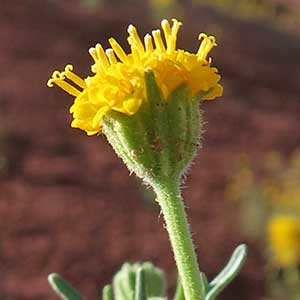Chaenactis fremontii
Chaenactis nevii
desert pincushion, Fremont pincushion, Fremont's pincushion, pincushion flower
John Day pincushion, John Day's pincushion, Nevius' chaenactis
mostly 1–12;
branches mainly proximal.
mostly 1–3;
branches mainly distal.
basal (withering) and ± cauline, 1–7(–10) cm;
largest blades linear and terete or ± elliptic and plane, ± succulent, 0–1-pinnately lobed;
lobes 1–2(–5) pairs, remote, ± terete.
basal (withering) and cauline, 2–5 cm;
largest blades ± elliptic, ± plane to 3-dimensional, not succulent, 1–2-pinnately lobed;
primary lobes mostly 3–8 pairs, ± remote, ultimate lobes ± plane to involute.
2–8(–10) cm, distally usually ± stipitate-glandular and, sometimes, ± arachnoid (at least early, often glabrescent by fruit).
1–6 cm, distally stipitate-glandular and, sometimes, ± arachnoid to villous.
± hemispheric to obconic (bases pale and ± truncate in fruit).
± hemispheric to campanulate.
corollas white to pinkish, 5–8 mm (inner);
peripheral corollas spreading, zygomorphic, enlarged.
corollas bright yellow, 4–6.5 mm;
peripheral corollas ± erect, actinomorphic, scarcely enlarged.
longest 8–10(–12) mm;
outer usually glabrescent in fruit, apices erect, acute, ± rigid.
longest 6–9 mm;
outer predominantly stipitate-glandular and, sometimes, ± arachnoid to villous in fruit, apices ± erect, acute, rigid.
(± radiant) mostly 1–5 per stem.
mostly 3–9 per stem.
(3–)6–8 mm;
pappi of (1–)4(–5) scales in 1 series, longest scales 6–8.5 mm, lengths 1–1.3 times corollas (apices visible among corollas at flowering).
3.5–6 mm (compressed);
pappi 0 or coroniform (of ± 10 scales, longest 0.1–0.5 mm).
= 10.
= 12.
Chaenactis fremontii
Chaenactis nevii
Chaenactis fremontii is often the most abundant spring wildflower in the lower Mojave and northern Sonoran deserts, where it is reported to be a significant food source for desert tortoises (Gopherus agassizii Cooper). It also extends seaward into the southern San Joaquin Valley area of west-central California, often as hybrids with other taxa (see sectional discussion).
The involucre bases described above are characteristic of Chaenactis fremontii and can help separate it from some forms of C. stevioides.
(Discussion copyrighted by Flora of North America; reprinted with permission.)
Chaenactis nevii is known from the John Day Basin area in Gilliam, Grant, Jefferson, Wasco, and Wheeler counties. This odd and isolated species combines traits of C. artemisiifolia (sect. Acarphaea) and C. glabriuscula, and might be descended from their common ancestor.
(Discussion copyrighted by Flora of North America; reprinted with permission.)


